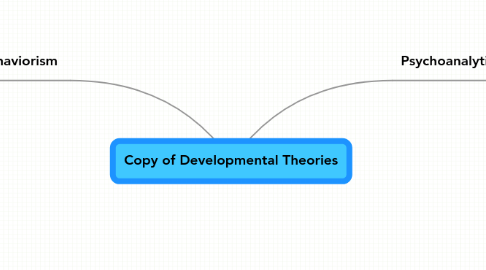
1. Behaviorism
1.1. Learning Theory
1.1.1. "social Learning"
1.2. Based on Seen Empirical Datum
1.3. Argued: "no way to measure Unconcious Processes"
1.4. Habits learned step-by-step
1.5. Used "conditioning"
1.6. Ivan Pavlov's Classical Conditioning
1.6.1. Neutral stimulus for Meaningful stimulus
1.7. B.F. Skinner's Operant Conditioning
1.7.1. System of rewards and punishments
2. Psychoanalytical
2.1. Freud
2.1.1. Psychosexual
2.1.2. Oral
2.1.2.1. (Birth-1 Years)Mouth, Tongue and Gums Center of Pleasure in the body
2.1.3. Anal
2.1.3.1. (1-3 Years) Anus is the center of all pleasurable activity i.e.Toilet Training
2.1.4. Phallic
2.1.4.1. (3-6 Years) Phallus most important part of the body and center of all pleasurable activities. Boys proud of their own and sense of despair and envy for girls
2.1.5. Latency
2.1.5.1. (6-11 Years) Interlude during which all sexual stimuli is quieted and put to more productive aqctivities e.g. Schoolwork, Sports
2.1.6. Genital
2.1.6.1. (Adolescence) The Genitals are the focus of all pleasurable sensations and a young person seeks out sexual stimulation through relationships
2.2. Felt that unconcious conflicts rooted in childhood experiences affected how they treat their children
2.2.1. Also according to Erikson life was a constant conflict between two states, i.e. Trust Vs. Distrust.
2.3. Erikson
2.3.1. Psychosocial
2.3.2. Constant Conflict
2.3.3. Trust Vs. Mistrust
2.3.3.1. Babies learn to trust others for physical needs including Physical contact, nourishment and where they learn to trust others or not.
2.3.4. Autonomy Vs. Shame and Doubt
2.3.4.1. They learn new activities to be self sufficient like toileting, walking etc.
2.3.5. Initiative Vs. Guilt
2.3.5.1. Children either learn to do adultlikr activities, or are fearful of those limits set by parents
2.3.6. Industry Vs. Inferiority
2.3.6.1. Children learn to be competent or feel inferior to do well in activities
2.3.7. Identitiy Vs. Role confusion
2.3.7.1. Adolescents try to figure out their role in society like their politics, career or be confuse as to what role to play
2.3.8. Intimacy Vs. Isolation
2.3.8.1. Young people try to find relationships and love or become isolated because of fear of rejection and dissapointment
2.3.9. Gnerativity Vs. Stigmatism
2.3.9.1. Make babies and procreate, contributing to the next generation or stagnate.
2.3.10. Integity Vs. Despair
2.3.10.1. Older adults try to make sense of their lives, eith seeing life as fullfilled and meaningful or feeling despair for goals never reached.
